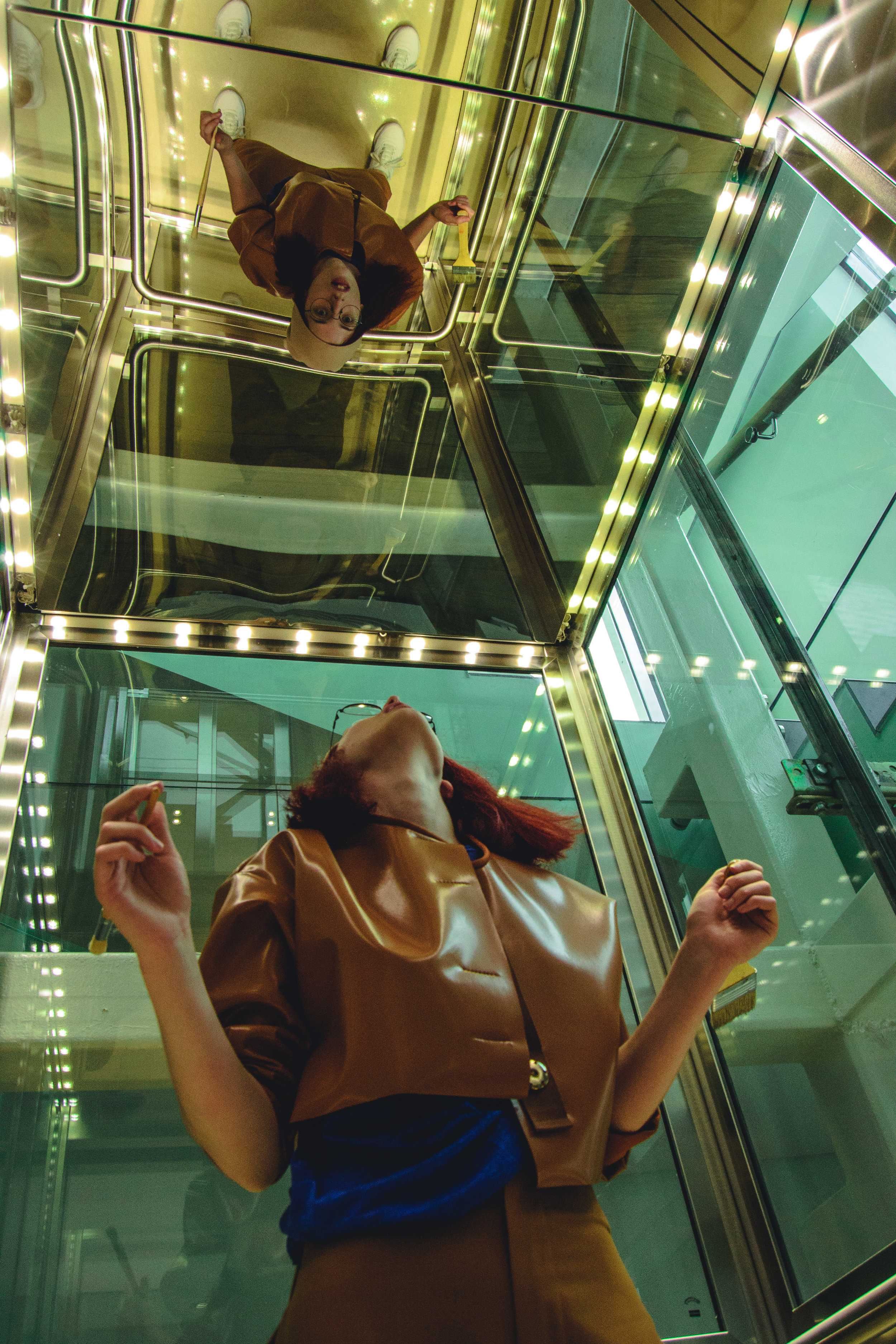Why do out of body experiences happen?
As is now traditional in the spookiest and soupiest of months, let’s delve into the psychology of something a wee bit creepy. This time, it’s out of body experiences! If you enjoy the blog, a link to previous 🦇🎃👻VERY SPOOKY👻🎃🦇 posts on déjà vu, superstition and why we believe in ghosts is available at the end. Happy Hallowe’en!
Before we can understand what an out of body experience is, we have to figure out what it means to be in a body. This looks like a simple enough question, so let’s try to answer it. My body is the physical part of me (or the whole of me, depending on which philosophical or religious ideas you subscribe to) which interacts with the world and in which my sense of self is situated.
OK, great. Next question: how do we know that the self is in this body and not another body? This is less easy to answer, but let’s have a go. Some clues: I have a unique visual perspective on this body that no-one else can have; I can feel internal processes of this body like digestion and heart rate; if I decide to move my right hand then it is the right hand of this body that moves; when I feel emotions I feel them in this body (and I have a deep emotional attachment to this body, too). All of this information and more is integrated by my brain to provide me with a vivid sense that I belong in and to this one body, even if I can see another body that looks just like this one in the mirror.
Please imagine I made a pithy Esme-Weatherwax-in-the-hall-of-mirrors reference here
If you don’t understand what I mean then please also read Witches Abroad.
Out of body experiences are just one of a larger group of experiences called autoscopy, which is from two Ancient Greek words: autos, meaning “self”, and skopós, meaning “watcher”. As we will see, these kinds of experiences can be a sign that something is wrong, but they can also happen if you are healthy, as a result of things like getting too much or too little sleep.
Autoscopy comes in many different forms, but we can dive them into six main types:
Autoscopic hallucination, which is a visual hallucination of yourself as though seen in a mirror – though the hallucination could look different from how you currently are, for example in terms of age or gender.
Feeling of a presence, which is a somatosensory hallucination – that is, it involves bodily perceptions like feelings of warmth or an altered sense of balance – without any visual hallucination and evokes the sense that another person is nearby (C R E E P Y).
Heautoscopy proper, which is like an autoscopic hallucination and a feeling of a presence together – both visual and somatosensory components. For people experiencing this kind of autoscopy, it can be very difficult to tell what is the real body and what is the hallucination even though it is experienced from the perspective of the real body.
Out of body experience, which is like heautoscopy proper in that there are somatosensory and visual hallucinations but rather than being seen from the perspective of the real body, it is as though the person experiencing it is outside their own body. These kinds of experiences can often feel profoundly meaningful to the person having them.
Negative heautoscopy, which is having no visual or somatosensory perceptions about your own body (or part of your own body), even when looking at it directly or in a mirror.
Inner heautoscopy, which is like heautoscopy proper but restricted to the inner organs, which are hallucinated outside the body.
While I’ve never experienced autoscopy, all of these sound completely terrifying to me – and while I find inner heautoscopy particularly argh-no-fucking-thanks-mate, there’s a strong argument for autoscopic hallucinations and heautoscopy proper as The Worst, because in these types of autoscopy people sometimes report being attacked by or attacking their hallucinations.
Now, I don’t know about you, but normally when something scares me, I arm myself with information because knowledge is power. So…
What’s happening in the mind and the brain when someone has an out of body experience?
Unusually, almost every paper I read about this was broadly in agreement about what’s going on in the brain, though there was a bit more of a disagreement about what’s going on in the mind. This difference in the amount of agreement might surprise you, but the explanation is pretty mundane: we have almost no idea what’s going on in the brain, nor how what we do know is going on relates to conscious thought.
An aside about brain imaging
Brains don’t actually “light up” - but that’s not the main problem here.
I get super annoyed at newspaper articles about brain imaging which say things like “X part of the brain lights up when we think about Y”. This is not because the brain doesn’t literally glow in the dark, since it would be extremely hypocritical of me to get annoyed about that. I am the kind of walking metaphor generator who would write an article about how making blood cells is like organising a pot luck dinner (yep, I taught myself blood cancer science for a previous job and if you need someone who can quickly digest, sort and re-write complex information in a form that’s comprehensible to a general audience then please check out my Hire Me page).
ANYWAY: the problem isn’t that the brain doesn’t glow, because we’re using that metaphor to help people understand that the brain is active. It’s that when we say “a part of the brain” we’re talking about maybe a millimetre cubed of brain, because that’s the zoomiest-in that we can zoom in with current brain imaging technology. That doesn’t sound like much, but do you know how many brain cells you can fit in a millimetre cubed? Literally millions, and I do not mean literally in the figurative sense. So, if part X of the brain is active when we think about Y and also when we think about Z, that may or may not mean that the same brain cells are active, and we should interpret any study that talks about this kind of overlap in brain activity with extreme caution.
The other problem is that when we look at images of brain activity, we are making an awful lot of assumptions. Let’s take fMRI as an example, since it’s used in quite a lot of studies. To a non-expert, an fMRI looks like a picture of thinking happening, but if we interpret it in that way then we’re making three assumptions, and we’re not totally sure if any of them are right:
- The fMRI machine is accurately gauging how much blood is flowing near different parts of the brain.
- More blood flowing near a particular part of the brain means that the brain cells in that part of the brain are active.
- The biggie: that the activity in that part of the brain is related to or responsible for thoughts that are happening, which seems like a reasonable assumption until you find out about this study on the brain activity of a dead fish.
If you would like to know more about the problems of assuming that we do our thinking with our brains, I highly recommend Out of Our Heads by the philosopher Alva Noë. While you’re waiting for it to arrive, let’s go back to studies about what the brain and mind are doing during of body experiences, remembering to take these brain imaging studies with a very large pinch of salt.
Almost every brain imaging study I read about out of body experiences pointed to the temporoparietal junction (or TPJ), which has this name because it is where the temporal lobe and the parietal lobe of your brain meet. If you would like to locate your TPJ, put your fingertip on your head where the top of your ear is attached. Move it up a couple of centimetres, then back about five centimetres. There, just under your skull, is your TPJ.
Assuming you have a standard brain, in fact you have two TPJs, one on the left and one on the right. Findings from some studies suggest that the left TPJ is important for autoscopy, while others suggest that it’s the right TPJ that’s involved. This isn’t a particularly important distinction unless you want to develop an expert understanding of autoscopy, so I’m going to carry on talking about the TPJ in general terms – if you want to know more, then follow the links to see the scientific papers I’m citing! Either way, the TPJ is believed to be responsible for integrating sensory information from inside and outside the body: where the limbs are in relation to each other, whether we are balanced, what we are seeing, and so on. If the TPJ has some kind of blip in its functioning, then this information doesn’t get integrated properly, and researchers believe that that’s when an out of body experience happens.
What sort of things might cause the TPJ to have a blip? Well, one other interesting aspect of autoscopy is that the position of the body seems to matter. Autoscopic hallucinations are more likely to happen when you’re seated or standing, while out of body experiences tend to occur when you’re lying down. One possible reason for this is that out of body experiences are associated with sleep paralysis, which is the deeply unsettling experience of being temporarily unable to move or speak as you fall asleep or wake up – i.e. at a time when you are probably lying down in bed. Out of body experiences that happen during sleep paralysis may be the result of too much or too little activity in the areas of your brain that are related to balance, in turn leading to problems with integrating that information in the TPJ.
Out of body experiences and medical conditions
One of the reasons we need to be cautious about the research on out of body experiences is that a lot of the people who’ve taken part in this research have some other condition that is linked to the out of body experience, like epilepsy, schizophrenia or anxiety. It is very difficult for researchers to cause out of body experiences to happen in the laboratory, so without volunteers with these conditions kindly taking part in experiments, we’d know almost nothing about out of body experiences. However, we can’t be sure how much the out of body experiences these volunteers have are like the out of body experiences other people have.
Let’s take a look at why out of body experiences are more common in people with these conditions.
Epilepsy is pretty easy to explain: in some people, the cause of epilepsy is damage to a part of the brain. If the damage is at the TPJ, then out of body experiences might happen during a seizure.
Schizophrenia and depression are a little harder to explain. People with schizophrenia often feel like their bodies have changed size or shapei, and can sometimes have autoscopic hallucinations in which schizophrenia-related behaviours are carried out by the hallucination – which, if you have schizophrenia, can actually be helpful in relieving the urge to carry out those behaviours yourself! Similarly, people with anxiety are also more likely than others to have body dysmorphia (perceiving some aspect of their appearance as seriously flawed). In both schizophrenia and anxiety, then, it seems like information about different aspects of the body might not be getting integrated properly by the brain, similar to what happens in out of body experiences. However, it’s not really clear exactly how these conditions are related to out of body experiences.
Creating out of body experiences
As I said earlier, it’s difficult for researchers to cause out of body experiences in the lab, but there are some promising findings. Some of these involve specialised equipment that can stimulate the brain, but the only successful experiments I’ve found have involved directly stimulating the brain (for example, with electrodes that had been implanted to treat tinnitus, or ringing in the ears). Stimulating the brain from outside the skull doesn’t involve major surgery, but also doesn’t seem to work…
Luckily, there is a method that does work, doesn’t require any brain stimulation at all, and involves expensive but at least widely available equipment.
Get ready to experience something weeeeeeird
You will need a camera, a virtual reality headset, some connecting cables, and a willing friend to act as an assistant. Simply (“simply”) arrange the camera so that the lens is the same height as your eyes, then stand with your back to it, connect to the VR headset and put the headset on. You will now see your own body as though you are standing behind it from the point of view of a ‘fake’ body where the camera is. This will not be enough to create an out of body experience, which is why you need a friend! They will need to gently tap your collarbone while also ‘tapping’ the equivalent area underneath the camera in the same rhythm, so from inside the headset it looks as though your collarbone is being tapped both on your actual body and on the fake body. After a couple of minutes, you should start to feel like the fake body is your real body.
These kinds of illusions don’t necessarily work for everyone, but if you’ve got the equipment to do it then I hope you have fun trying!
If you enjoyed this blog, you might also like my other Hallowe’en-themed blogs!




